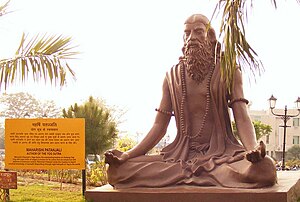
Ashtanga yoga (Sanskrit: अष्टाङ्गयोग, romanized: aṣṭāṅgayoga[1], "the eight limbs of yoga") is Patanjali's classification of classical yoga, as set out in his Yoga Sutras. He defined the eight limbs as yamas (abstinences), niyama (observances), asana (posture), pranayama (breathing), pratyahara (withdrawal), dharana (concentration), dhyana (meditation) and samadhi (absorption).
The eight limbs form a sequence from the outer to the inner. The posture, asana, must be steady and comfortable for a long time, in order for the yogi to practice the limbs from pranayama until samadhi. The main aim is kaivalya, discernment of Puruṣa, the witness-conscious, as separate from Prakṛti, the cognitive apparatus, and disentanglement of Puruṣa from its muddled defilements.
- ^ Huet, Gérard. "Sanskrit Heritage Dictionary". sanskrit.inria.fr. Retrieved 2020-08-31.